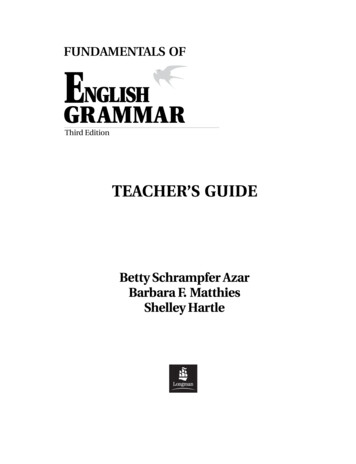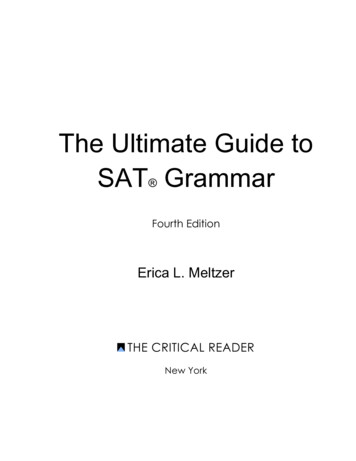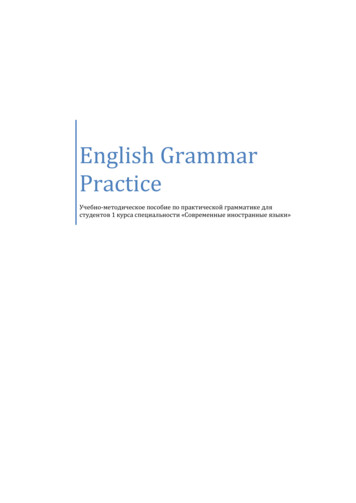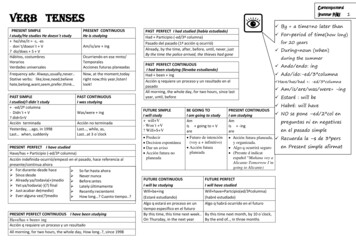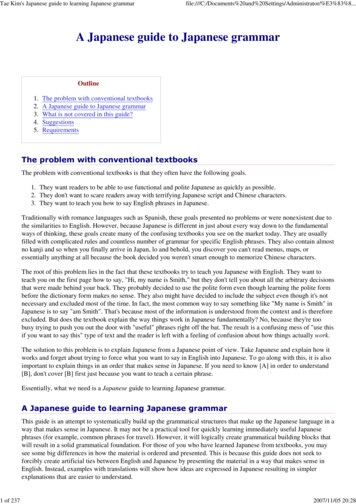
Transcription
Grammar HandbookCapella University 225 South 6th Street, 9th FloorMinneapolis, MN 55402 1-888-CAPELLA (227-3552)
Grammar HandbookTable of ContentsIntroduction. 3Sentence Basics . 4Sentence Structure. 19Paragraph Structure. 25Word Choice . 34Punctuation. 47Mechanics . 692
Grammar HandbookIntroductionMany types of languages are used throughout the world to communicate dailyour countless ideas, beliefs, intentions, actions and feelings. And with massmedia and the Internet, this interaction is occurring faster and more frequentlywith every passing second. Even specialized languages, such as mathematicsand computer programming, are being used more often in an effort to createmuch desired and needed new processes and systems and to educate people.Therefore, as members of a growing global village encompassed by our dynamicinformation age, good language expression, usage, and comprehension are vitalnot only for accurately communicating with each other in many different waysand on many different levels, but also for correctly communicating with andmanaging our machines, structures and other synthetic systems as well as theorganic systems we’ve inherited.Like most of the systems in the world and universe in which we live, languagesare organic and continuously evolving systems within larger changing systems,such as our local, national and international communities. Within all languages,cultural traditions and conventions have shaped, organized, re-organized andnormalized language subsystems, thereby, structuring overall language systems.So like culture, itself, language is ever-developing as conventions and traditionalsystems are forever challenged and language structure is permanently altered.Besides the inherent ever-evolving nature of languages, in a global informationage much can be lost in translation between different languages and in theinevitable meshing of cultures. Therefore, information dissemination andcomprehension can be a challenge. However, as with many organic systemsand their subsystems, chaos is a natural part of cycles, and in an allencompassing global and ever-changing technological environment, as culturesand languages collide, they also merge to become one.3
Grammar HandbookSentence BasicsParts of SpeechParts of speech are sentence elements that work together to make up asentence. Just as a car is not a functioning car without all of its synchronizedparts working together, a sentence is not a functioning sentence without thecorrect usage and combination of its essential parts of speech. The difference isthat not all basic sentence parts—or parts of speech—have to be included all ofthe time to actually make up a complete and functioning sentence, but its partsdo have to work together accurately for a writer to convey his or her intendedideas. The basic parts of speech include: Noun, Pronoun, Verb, Adjective,Adverb, Preposition, and Article.Nouns A noun is a word describing who or what in a sentence—it can be a person,place or thing. Remember, a “thing” can be anything—an animal, a device, apoint, an object, an event, and so on. A noun is usually an essential part ofany basic sentence. It’s typically who or what the sentence is about, but othernouns are often also included in longer or more complex sentences.Noun Examples:oooooooLarry smiled.Larry smiled at Isabel, Kevin, and their two dogs, Trevor and Lance.Trevor and Lance were watching a show on Animal Planet.Alaska is home to many interesting creatures.That plain red wooden chair in the corner is a priceless antique.The iceberg was massive underneath the water.Austin, Texas is known as the “Live Music Capital of the World,” ibut the New York Times created controversy when it referred to it asthe “Live Music Capital of the South.” ii A proper noun names a particular person, place or thing, and the first letter ofa proper noun is always capitalized. From the examples listed above, Larry,Isabel, Kevin, Trevor, Lance, Animal Planet, Alaska, Austin, Texas, “LiveMusic Capital of the World,” New York Times, and “Live Music Capital ofthe South” are all proper nouns. Common nouns are not specific and don’t require capitalization. From theexamples listed above, dogs, show, creatures, chair, corner, antique,iceberg, and water are all common nouns.4
Grammar HandbookPronouns Pronouns can be used in place of nouns (when appropriate), and a pronounoperates just like a noun in a sentence. It’s important to remember, however,to use pronouns carefully. Often times, writers make the mistake of referringto a noun with a pronoun without first providing and introducing the actualnoun a pronoun is replacing. This creates confusion for readers since it’sthen not clear who or what a pronoun is referring to. Also, once introduced,nouns should be mentioned again here and there throughout a paragraph toremind readers of the name or title of a noun (or noun phrase) even if it’s onlya common noun, such as “philosophy student” or “kitten.”Nouns should be renamed even more often when many different nouns arebeing talked about in the same paragraph, especially when writers aredescribing interaction between characters or objects e.g., He swore to herhe would never deceive her again even though she was the one who had firstlied to him about it after he told her what the other man told him she said.How many people are being referred to in the previous sentence? Whenstarting a new paragraph, it’s also a good idea to re-introduce a noun in thefirst sentence since readers typically look for a change in thought or directionin a new paragraph.On the other hand, it is a good idea to use plenty of pronouns intermittentlythroughout paragraphs to replace nouns (once they’ve been introduced) sothat all sentences don’t begin exactly the same or follow the exact samepattern each time. Sentences may start to sound redundant or choppy (andsometimes boring) when they’re all the same and become very predictable toreaders. Without sacrificing meaning and direction in your paragraphs, it’sgood to mix it up a bit with sentences. Personal pronouns tend to come to mind first when we think about pronouns.It’s because most people use them a lot in their writing, and most writersinstinctively know to use personal pronouns when referring to people or thingseven if they’re not always sure when or how often to use them. The mainthing to remember about personal pronoun usage is that it is based onnumber, person and gender.However, with the factor, gender, a lot has changed over the years in Englishlanguage usage when it comes to the political correctness (PC) of referring toa person by their gender. It’s something to keep in mind when writing sincethe main change has to do with writers no longer automatically referring to ananonymous someone as “he” or “him.” For instance: “A baseball pitcher mustwork constantly on the accuracy of his pitch.” How do we know the pitcherisn’t female? So, it’s better to replace the word “his” with either “his or her” orwith the word “their.” Even though “their” is typically known as a plural5
Grammar Handbookpersonal pronoun, it has now become an acceptable and gender-neutral wayto refer to someone: “A baseball pitcher must work constantly on their pitch.”(More information on gender can be found in the Sexist Language sectionunder Word Choice in this handbook.)Another thing to remember about personal pronouns is that when writers usecertain statements or commands, such as “Stop!’ or “Listen to me!” thepersonal pronoun “you” is implied “You stop!” or “You listen to me!”Personal PronounsPerson1st Person2nd Person3rd PersonNumberSingularI (my, me)you (your, you)he (his, him)she (her, her)it (its, it)Pluralwe (our, us)you (your, you)they (their, them)iiiPersonal Pronoun Examples:oooooooHe smiled at them, but I wish he would also smile at me.You gave me your new recipe, so of course my lasagna tastes great.Today, they watched it until she arrived; you will have to watch it allday tomorrow.A philosophy student spends a lot of time writing papers for his or hercourses.A law student spends hours studying their law books. (gender-neutral)They gave him to us yesterday, and we are really enjoying our newkitten.Its name is Sunflower.Note: In most of the examples above, it’s not always clear who or what thesentence is about (besides a pronoun of some type). That’s why it’simportant for a writer to make sure readers always know who or what is beingreferred to before using a huge splattering of personal pronouns to replacenouns in a paragraph. Personal pronouns and slang go together like well, a lot of people use slangpronouns. And in common everyday conversation, it’s usually veryacceptable; however, as most academic writers probably know, words like“y’all” aren’t used in scholarly writing unless a writer is directly quotingsomeone else using such a word. Depending on various cultures andregions, different versions of the plural form of the pronoun “you” are used.Other slang personal pronouns include but are not limited to “you guys”(referring to males and females), or “yous guys” and “yous.” It’s only6
Grammar Handbooknecessary, however, to use “you” when addressing more than one person.(The word “dude” iv or “dudes” has been used as a personal pronoun recentlytoo, but it’s also slang and shouldn’t be used in academic, business or formalwriting.) Pronoun confusion is common with certain personal pronouns:“I” versus “me”“we” versus “us”“it” versus “they”“I” is used as thesubject noun in asentence (person,place, or thing asentence is about),whereas “me” is usedas the object noun.Examples:I went fishing in theGulf of Mexico.(“I” who thesentence is about.)“We” is used as asubject noun in asentence (person,place, or thing asentence is about),whereas “us” is used asan object noun.Examples:We are vacationing inFrance next year.(“We” who thesentence is about.)Use the pronoun “it”when referring to asingular non-humannoun, but use “they”when referring to morethan one of anything.Gina and I will scubadive in Puget Sound.(“Gina and I” whothe sentence is about.)We, including severalother people fromanother club, areparticipating in the race.(“We” who thesentence is about.)I’m surprised you askedus to do the research.(“I” who the sentenceis about.)Sherry called me lastnight from London.(“Sherry” who thesentence is about.)You will give all of thecandy to Jimmy andme. (“You” who thesentence is aboutbecause “You" is thenoun performing theaction, “give,” eventhough it’s in thepossible future.)We heard you wereexcited to help us withthe marketing project.(The sentence is about“We” first because it isthe noun performing thevery first action,“heard.”)Examples:The lion pride was anamazing site to see onthe Serengeti eventhough it was from adistance. (“pride” “it.”)The corporation was verygenerous with itsdonations. (A corporationor any other type oforganization is a singleentity.)All of the people workingfor the small corporationwere well educated, andthey had all receivedtheir degrees fromCapella University.(People in anorganization “they.”)The data is organized bydivision, but it is notalphabetized orcategorized bydepartment.(“Data” can be used as asingular or plural noun.) v7
Grammar Handbook Note: Confusion often occurs also around the words “your” and “you’re.”The word “your” is a personal pronoun (refer to the Personal Pronouns chartin this section), and the word “you’re” is the contraction for the words “youare.” Unfortunately, technology and computers have not helped us any withword confusion. Many a person has recently sent an email or instantmessage (IM) reply to someone across the Internet cloud saying, “Yourwelcome!” Whose welcome?The possessive form of a personal pronoun is not punctuated with anapostrophe. For instance, many people get the words “its” and “it’s” mixedup. However, the word “its” is the possessive form of the pronoun “it,”whereas the word “it’s” is a contraction for the words “it is.”Possessive Personal Pronoun Examples:ooooooo Is that hamburger yours? (NOT: “your’s”)Where is hers? (NOT: “her’s”)Theirs was the first to compete in the race. (NOT: Their’s)His is the book next to hers. (NOT: “her’s”)Its characteristics are similar to the other dated sample’scharacteristics.(NOT: “It’s”)Ours is much bigger than yours. (NOT: “your’s”)It’s sad that Harry’s transferring to another university.(CONTRACTION)Reflexive pronouns are used only to reflect or refer back to the main noun ofa sentence or the subject—who or what the sentence is about.Reflexive Pronoun Examples:Jerome hurt himself playing tennis. (Jerome)oMichelle struggled with herself over the issue. (Michelle)oI said to myself I would never get behind on my studies. (I)oThe couple enjoyed themselves on vacation in Norway. (The couple)oWe set ourselves on the right course and never looked back. (We)oYou should prepare yourselves for a wonderful experience at therestaurant. (You)oIt duplicated itself after a massive exposure to radiation andchemicals. (It)ooNOT: The meeting will be attended by Miguel and myself. (Themeeting?)NOT: It’s only Cecilia and myself going. (It’s?)8
Grammar HandbookReflexive PronounsPerson1st Person2nd Person3rd selfPluralourselvesyourselvesthemselvesvi Intensive reflexive pronouns are used to emphasize the subject of asentence.Examples:oo He himself will be the first to admit he was wr
Grammar Handbook. Capella University 225 South 6th Street, 9th Floor . Minneapolis, MN 55402 1-888-CAPELLA (227-3552)


